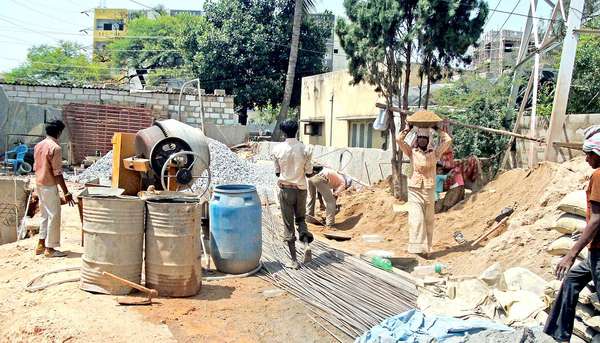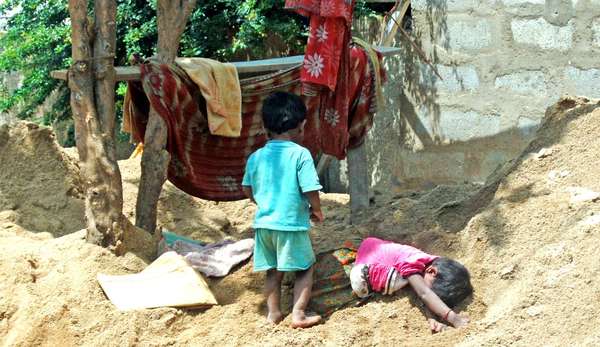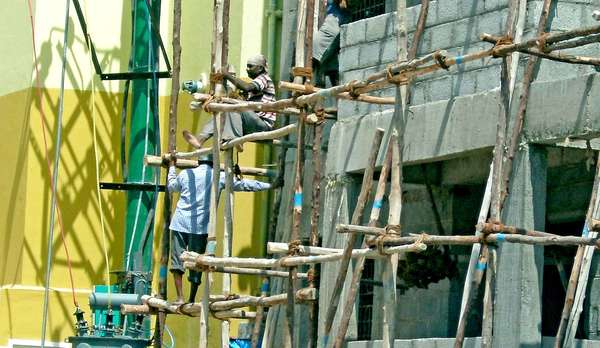Frail women carrying bricks or sand on their head and walking in the heat, sometimes with a small kid tagging along. Men in dusty, faded clothes with dry, rough hands smearing cement on the well-laid bricks or sprinkling water on a building that has just been cemented. This is a pretty common sight in a city like Bangalore that is ever-growing, ever-expanding and constantly in the process of being built or rebuilt.
Building construction workers are growing in numbers every day, with constructions going on in any given road at any point in time.
Labourers at work in the construction site. Pic: Nalme Nachiyar
General Secretary of the Karnataka State Construction Workers Central Union (KSCWCU), C Palanikumar estimates that there are around 12 to 15 lakh workers today in the city. The union, as a part of its objectives, tries to organise these workers, assists in availing educational benefits, medical aid, maternity and child welfare benefits, promotes and provides skill up-gradations and technical training, etc. Along with the Karnataka Building and Other Construction Workers Welfare Board, the union tries to enrol and register as many workers as possible, so that they can avail the welfare schemes from the government.
What is alarming, however, is that only 2,70,352 workers have registered with the Welfare Board till date. And as per the Board’s regulations, only the enrolled workers have access to the provisions given by it. When asked if it has any plans of getting more people to enrol, T Srinivas, Joint Labour Commissioner (CWB), Labour Department says: “The Board plans to publish posters and put them up in the areas where there is a concentration of construction workers. We also plan to publicise in all the gram panchayats the process of enrolment and the subsequent benefits. This plan was drawn up in the last board itself. But we had two elections after that, so it wasn’t approved. Now the issue will be taken up with the Chairman, we’ll call for tenders and implement this campaign soon.”
But what if the target audience, comprising mainly of illiterates, is not equipped with the tools to understand this message? How will they understand what is in these posters? Worse, what about the gradually increasing migrant worker population? Projects like the BMRCL employ a lot of workers coming down to Karnataka from Bihar, Orissa, Uttar Pradesh and Madhya Pradesh. How will this floating population, with no knowledge of the native language in which these posters are published, make sense of them? Is there any other way these people can reach out for assistance?
“We have launched a toll-free number”, explains Srinivas. “This helpline operates in three languages – English, Kannada and Hindi. The workers can dial 18004252838 and find answers to their queries. Or they can register on the spot when the labour inspector and labour officers approach them in case they aren’t able to come to the Labour Department and get it done”.
Toddlers at the construction site. Pic: Nalme Nachiyar
Palanikumar has a slightly different view. Despite all the efforts that the Board is putting in, he feels that construction workers, especially the migrant population, themselves are not interested in getting registered. “We tried to reach out to the grassroot levels and went to the field asking people to enrol. But the workers say they will be here for a very short period till the construction is complete after which they will move on to another place. So what is the use of having a card, they ask.”
However, feeling the need for a little more publicity, he agrees that, the Board must also issue ads in the newspapers and the television. Even if they do not know to read, most of them have access to television. Attempts should be made to reach out to them through these means.”
So what do the labourers feel about what the board is doing for them? Are they satisfied? Do the benefits reach them? Are their needs being met? Or is there a disparity between what the Board wants to do and thinks it is doing to what is actually being done? Kullayappa (56), the Chairman of the Karnataka State Construction Workers Central Association for JJR Nagar, Sangam Circle says, “So far, despite occasional lapses from the Board’s side, things are going fine to a certain extent. Most of us in this area are registered with the Board and some of us have also availed the benefits. The benefits which are used often are related to education and medical relief.”
However, the situation is not so rosy always. Bhupathi (38), the executive member of this small association, feels that the education benefits provided to their children is nowhere enough to meet the costs of education. “Out of the 2,000 rupees the Board provides per year for children studying from 5th to 7th standard, 1,000 rupees go away in buying the textbooks itself. How are we to manage the costs of the notebooks, the uniform and the school fee?”
Hyder Ali (55) and Venkatesh (42) express their concerns over the delayed release of medical aid. “When a worker is admitted to the hospital due to an injury or illness, the Board takes its own time to sanction the release of funds. As in the case of 58-year-old Anjanappa’s heart surgery, there have been times when all of us have come together and pooled the money for treatment.” The application to release the fund for his surgery was given in January 2013, around the time his surgery was due. It has not been released till date.
Workers fastening ropes to the poles. Pic: Nalme Nachiyar
There are complaints regarding the marriage benefit scheme too. Lakshmi (28), an unregistered worker who has been in construction labour since 10 years says “Three years ago when I got married, the 50,000 rupees allotted as marriage benefit wasn’t given to us.” Similar is the case with marriages of Kullayappa and Chinnaswamy’s children.
Srinivas clarifies the scheme of things in providing medical relief. “What happens with medical relief is that the documents are not always right and in such a case we cannot blindly give them money. Also, due to the regulations of the Election Code of Conduct, we hadn’t sanctioned anything. But now that everything is over, we will start releasing the money.”
Housing is another woe. While some workers live in rented houses that squeeze 2,000 to 3,000 rupees off them every month, others still live in tents and shacks. Water and electricity problems apart, the security of their womenfolk is another major concern.
“But what choice do we have? We cannot stop working and sit behind to take care of them. And our women are strong enough to understand this,” they say . But more than houses, they need a small place to meet and discuss their problems, Kullayappa observes. He wonders what the Board is doing with the 700 Crores collected via cess.
The Building and Other Construction Workers Welfare Cess Act 1996 was introduced by the Government of India to provide for the levy and collection of a cess on the cost of construction incurred by employers with a view to augmenting the resources of the Building and Other Construction Workers’ Welfare Boards that was set up in 2007.
So what really is the Board doing with these 700 Crores? “1750 Crores”, Mr. T Srinivas corrects. “As of now, we don’t have any housing scheme. But there are plans to build ‘group houses’ in Bangalore, Mysore, Hubli and Mangalore. We are planning to build around 600 houses that will be given to the builders in order to house the workers who are employed by them.”
While the KSCWCU and the Welfare Board insist that enrolment and acquisition of a registered card is the answer to their problems, the labourers believe that it is easier said than done. New applications that take forever to get processed, renewal of applications that are delayed without reason and benefits that are constantly evading them; the workers have had enough running to do from pillar to post. They are putting forth their own “workable” demands in front of the Board.
One of their major demands is the provision of a health card without which the hospitals are not ready to treat them. The cards given by the Board seem useless as does the amendment of the provision that enables them to get treatment from all government and government recognised hospitals. The second is the pension without which men and women whose retirement ages are 60 and 55 respectively, find it hard to manage their lives. The third major demand is the increase in education benefits. “We do not want this money as mere scholarship but something that will help us educate and give a better life to our children. We don’t even want the money to come into our hands. The Board can directly address the DD to the schools of our children. That’s all we want of them,” says Bhupathi.
The benefits and welfare schemes have never reached the needy unorganised construction workers. It remains to be seen how the newly formed government is going to address the issue to ensure the welfare of the sector.
|
Welfare Benefit Enhancement Details: 2007 -2012 |
|||
|
Sl. No. |
Benefit |
Year 2007 |
Year 2012 |
|
01. |
Pension – Old age |
Rs. 300 |
|
|
02. |
Pension – Disability |
Rs. 300 |
Rs. 500 |
|
03. |
Purchase of Tools |
Rs. 5000 |
|
|
04. |
Purchase or construction of house |
Rs. 50,000 |
Rs 2 lakhs (5% interest and 50,000 subsidy) |
|
05. |
Maternity |
Rs. 4,000 |
Rs. 15,000 |
|
06. |
Funeral Expenses – Natural Death |
Rs. 2,000 |
Rs. 50,000 |
|
07. |
Education Assistance: |
||
|
a) |
5th to 7th std |
NIL |
Rs. 2,000 |
|
b) |
8th to 9th std |
NIL |
Rs. 3,000 |
|
c) |
SSLC |
Rs. 750 |
Rs. 5,000 |
|
d) |
PUC I year (promoted) |
NIL |
Rs. 5,000 |
|
e) |
PUC II year (promoted) |
Rs. 1,000 |
Rs. 5,000 |
|
f) |
ITI – Diploma |
Rs. 2,000 |
Rs. 5,000 (each year) |
|
g) |
Degree |
Rs. 1,500 |
Rs. 5,000 (each year) |
|
h) |
Post Graduate Degree |
Rs. 5,000 |
Rs. 15,000 (each year) |
|
i) |
Professional Courses: |
||
|
j) |
Engineering |
Rs. 5,000 |
As per Govt fees + Rs. 1,000 per month as attendance incentive |
|
k) |
Medical |
Rs. 5,000 |
As per Govt fees + Rs. 1,000 per month as attendance incentive |
|
08. |
Medical Assistance: |
||
|
a) |
Sickness |
Rs. 400 to Rs. 2,000 |
Rs. 400 to Rs. 6,000 |
|
b) |
Critical Illness |
Rs. 10,000 |
Rs. 2,00,000 |
|
c) |
Accident |
Rs. 1,00,000 |
Rs. 2,00,000 |
|
d) |
Accident Disability |
NIL |
Permanent – Rs. 1,00,000 |
|
e) |
Accident due to building collapse – death/injury |
NIL |
NIL |
|
09. |
Marriage |
Rs.5,000 |
Rs. 50,000 |
⊕


